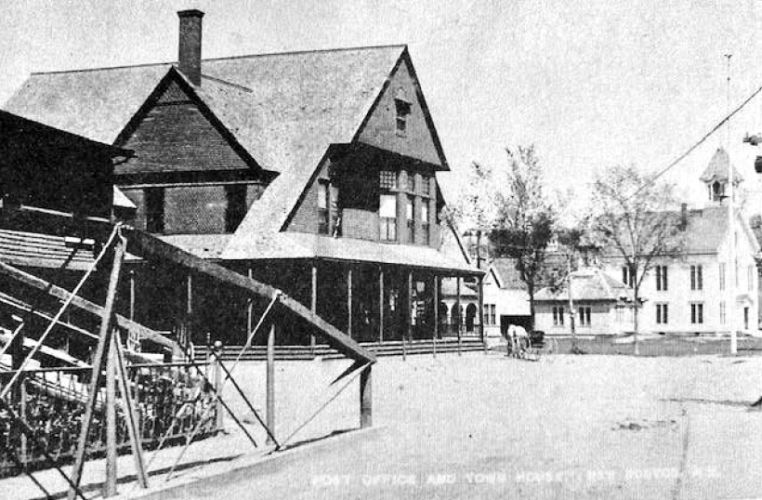New Boston Historical Society
New Boston, New Hampshire

The wrought-iron bridge that collapsed in 1947 is in the left foreground of this
photo, with Dodge's Store in the background.
The Village Bridge
by Mary Atai (December 2021)
Records show that Albert Goodwin was paid $12.50 for removing the old bridge. A large lamp was bought to hang from the new bridge. Over the years, this iron bridge required repairs several times, including after the flood of 1936 and after a load of soapstone being transported from Francestown broke through the flooring. There is even a story about a circus train passing through New Boston, with its elephant doing significant damage to the bridge.
But the incident that ultimately ended the use of the iron bridge happened on May 12, 1947. A tractor trailer carrying a 67-ton power shovel crossed over the bridge, rendering it irreparable. The vehicle made it across, but then the bridge, which had a posted 6-ton limit, immediately collapsed. Of course, not having a bridge in this central location caused all sorts of inconveniences to the people of the town.
A special meeting was called at town hall in June to decide how to move forward to remedy the situation. A decision needed to be made as to whether the town was willing to appropriate any of the capital reserve fund to complete the rebuilding of the bridge. Also, money would need to be approved to move the war memorial, which had sat in the triangle, where the Babson Memorial sits today, since 1921.
The war memorial has a story of its own. It was the idea of Eben Dodge, a prominent citizen, who wanted to honor New Boston's military men. Eben died in 1914 and left $2,000 to the town to carry out his wishes. The World War interrupted any work being accomplished toward that goal and so nothing was done until 1919.
Originally, the memorial was to contain the names of all men who fought from New Boston in the French and Indian War, the Revolutionary War, and the Civil War. Now they needed to add the soldiers from the just-ended World War. The monument was designed by artist Frank French and dedicated in May, 1921. It was placed in front of what was Dr. Charles Weaver's house at the time, in the grassy area in the middle of the road and sat there for 26 years. Now it would need to be relocated, as it would block traffic views with the new bridge configuration.
The Baptist Church had recently been demolished on the common and that land had been given to the town, so there was space. Clayton Chase was paid $575 to move the memorial to the spot where it now rests.
The new bridge, which we still use today, was in service by January, 1948. It is a reinforced concrete structure with a 70-foot span. Ultimately the state paid $18,000 and the people of New Boston paid $8,000 to replace the bridge.
The town sued the trucking firm (C.E. Hall and Sons, Inc. of Somerville, Mass.) responsible for the collapse of the iron bridge for $20,000. The driver of the vehicle, John L. Julianus, admitted he had seen the posted weight limit, but reasoned that since the vehicle was long, not all the weight would be on the bridge at any given time, so he could make it across. He was wrong.
Click here to return to the main page for "Behind the Door" articles.
